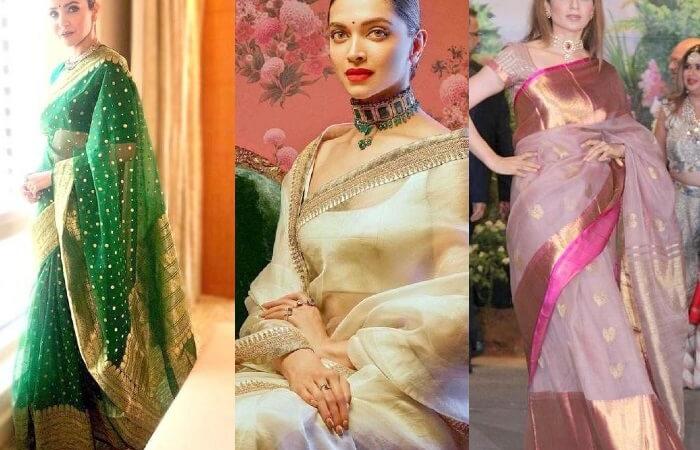Salwar Kameez – The Dress for Punjabi Women

The salwar (also spelled shalwar) kameez, popularly known as the Punjabi suit, is the traditional dress of women in the Punjab region of northwestern India and eastern Pakistan. The outfit comprises a pair of trousers (salwar) and a tunic (kameez) that is usually paired with a scarf (dupatta). In recent years, the salwar kameez has become a popular form of attire among Indian women throughout India as well as in Singapore.
Description
The salwar kameez is a traditional outfit worn by Punjabi women. It comprises a pair of trousers known as the salwar and a tunic called the kameez. Traditionally, the salwar trousers are tailored to be long and loose-fitting with narrow hems above the ankles that are stitched to look like cuffs. Punjabi men also wear the salwar, but they pair their trousers with a shorter tunic known as the kurta, which is the male version of the kameez.
The traditional kameez top is a loose-fitting, knee-length tunic with long sleeves. The tunic is worn by pulling it over the head through a round neckline that has a front slit.
The salwar kameez is usually paired with a long, sheer fabric scarf or shawl known as a dupatta, which is either draped across the neck or over the head. Decorative patterns may also be embroidered around the neckline, sleeves, hems, and side slits of the outfit.
Historical background
The salwar kameez is believed to have originated from the costumes of the Mughals, who were the Muslim rulers of India. Originally the traditional dress of the Punjab region, the salwar kameez gradually became popular among women throughout India. From the 1980s onwards, the salwar kameez was even adopted as a uniform for girls between the ages of 12 to 16 in India’s government schools. Many of these girls continued to wear the salwar kameez when they moved on to colleges and universities and even after they went out to work.
Prior to World War II, there were few Indian women residing in Singapore. The Indian community then comprised mainly of single men who came as laborers or businessmen. It was only after the war that more Indian women came to Singapore to join their husbands or families. Women from the Punjab region were part of this post-war wave of female Indian migrants and it was they who introduced the practice of wearing the salwar kameez to the Indian community in Singapore.
In contemporary Singapore, the wearing of the salwar kameez is no longer restricted to women of Punjabi heritage. Indian women and those of other ethnicities also wear the outfit, which is regarded as being comfortable, affordable, and flattering to the figure.

Modern varieties
The modern versions of the kameez are usually sleeveless and tend to be more tight-fitting than the traditional outfit. In addition, the kameez is no longer always paired with a salwar, with some women today choosing to wear their kameez tops over Western-style jeans, skirts, and pants.
Like other forms of dress, the length and width of the salwar kameez have been influenced by fashion trends. The width of the trouser cuffs on the salwar has ranged from as wide as 30 cm for the “pantaloon” look as narrow as 10 cm for “harem” pants. The length of the kameez has also varied from mid-thigh during the “mini” craze to well below the knee during the “midi” phase.


Cultural significance
The popularity of the salwar kameez among young Indian women is linked to societal changes. Traditionally, Indian girls would switch to wearing the Sabri when they got married, which was usually soon after puberty. But as women in India began to marry later, they faced a new dilemma of what type of dress to wear while they were still single adults. They could no longer wear the attire of their childhood but did not feel quite ready yet to wear the sari. Thus, they turned to the salwar kameez, which was seen as a suitable outfit that met their modesty requirements.
For many Indian women today, the salwar kameez is regarded as a functional outfit that suits their modern lifestyle needs better than the traditional sari. Unlike the sari, the salwar kameez does not have strong associations with tradition nor does it evoke anxieties about learning how to properly wrap and drape the outfit. In addition, its ease of wear allows women to move about more freely at the workplace.
Author
Stephanie Ho
Suggested Read: Traditional Dresses Of Indian States
References
1. Bhachu, P. (2005). Salwar-kameez. In V. Steele (Ed.), Encyclopedia of clothing and fashion. Detroit: Thomson Gale, p. 133. (Call no.: LR q391.003 ENC -[CUS])
2. Costumes through time: Singapore. (1993). Singapore: National Archives of Singapore and Fashion Designers’ Society, p. 113. (Call no.: RSING q391.0095957 COS -[CUS])
3. Ang, M. W. (2000). Costumes of Singapore. In K. M. Chavalit & M. Phromsuthirak (Eds.), Costumes in ASEAN. Bangkok: The National ASEAN Committee on Culture and Information of Thailand, p. 214. (Call no.: RSING 391.00959 COS -[CUS])
4. Ang, M. W. (2000). Costumes of Singapore. In K. M. Chavalit & M. Phromsuthirak (Eds.), Costumes in ASEAN. Bangkok: The National ASEAN Committee on Culture and Information of Thailand, p. 214. (Call no.: RSING 391.00959 COS -[CUS])
5. Ang, M. W. (2000). Costumes of Singapore. In K. M. Chavalit & M. Phromsuthirak (Eds.), Costumes in ASEAN. Bangkok: The National ASEAN Committee on Culture and Information of Thailand, p. 214. (Call no.: RSING 391.00959 COS -[CUS])
6. Biswas, A. (1985). Indian costumes. New Delhi: Publications Division, Ministry of Information and Broadcasting, Govt. of India, p. 123. (Call no.: R 391.00954 BIS -[CUS])
7. Banerjee, M., & Miller, D. (2003). The sari. Oxford: Berg, pp. 239–240 (Call no.: R 391.20954 BAN -[CUS])
8. Ang, M. W. (2000). Costumes of Singapore. In K. M. Chavalit & M. Phromsuthirak (Eds.), Costumes in ASEAN. Bangkok: The National ASEAN Committee on Culture and Information of Thailand, p. 208. (Call no.: RSING 391.00959 COS -[CUS])
9. Ang, M. W. (2000). Costumes of Singapore. In K. M. Chavalit & M. Phromsuthirak (Eds.), Costumes in ASEAN. Bangkok: The National ASEAN Committee on Culture and Information of Thailand, pp. 213–214. (Call no.: RSING 391.00959 COS -[CUS])
10. Leong, S. L. (2005, February 6). Kameez chameleon. The Straits Times. Retrieved from NewspaperSG.
11. Leong, S. L. (2005, February 6). Kameez chameleon. The Straits Times. Retrieved from NewspaperSG.
12. Changes in the Punjabi costume. (1981, August 18). The Straits Times. Retrieved from NewspaperSG.
13. Banerjee, M., & Miller, D. (2003). The sari. Oxford, New York: Berg, pp. 237–238. (Call no.: R 391.20954 BAN -[CUS])
14. Banerjee, M., & Miller, D. (2003). The sari. Oxford: Berg, pp. 245–246. (Call no.: R 391.20954 BAN -[CUS]).






